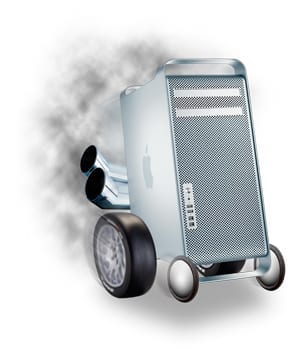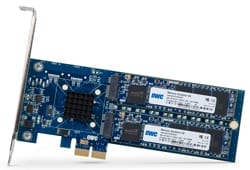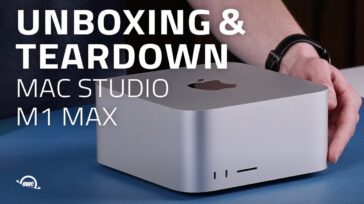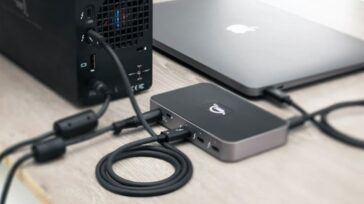 Though unmentioned in the WWDC Keynote and all but lost in the Retina display euphoric afterglow, the Mac Pro did get an upgrade in the form of a processor bump and a price drop. Now, the entry-level Mac Pro sports a 3.2GHz Quad-Core processor and 6GB of RAM for around $2500, which is both about 400MHz faster, approximately $500 less expensive, and features twice as much memory than the base option offered previously. Many authorities consider the sweet spot to be the 3.33GHz 6-Core model, which is available as a custom option.
Though unmentioned in the WWDC Keynote and all but lost in the Retina display euphoric afterglow, the Mac Pro did get an upgrade in the form of a processor bump and a price drop. Now, the entry-level Mac Pro sports a 3.2GHz Quad-Core processor and 6GB of RAM for around $2500, which is both about 400MHz faster, approximately $500 less expensive, and features twice as much memory than the base option offered previously. Many authorities consider the sweet spot to be the 3.33GHz 6-Core model, which is available as a custom option.
So long as you’re not thinking of it as “new” , but rather a “refresh” of the 2010 model line (which many will say it is), it’s fair to say the base speed/price adjustment represents a better value than the 2010 Mac Pro you could have bought a month ago.
However, that doesn’t change the fact that its been far too long since the last update. Considering how long this Mac Pro configuration has been in service and the technological advances since it was introduced, many Mac Pro users took this lack of an actual hardware upgrade as a slap in the face. These users are often professionals with heavy data processing needs. To them, having an “update” without the speed/expandability of USB 3.0 or Thunderbolt, much less relying on out-of-date processor technology, is ridiculous. As a result, there was a huge outcry by pro users over yet another “snubbing” of the Mac Pro from the upgrade cycle – so much so that even Apple relented and took down the “New” label off of the Mac Pro page.
If your business is in need of new Mac Pros and you were holding out in hopes of a refresh, you have several options. You can upgrade your current machines, buy the latest “refresh” machines, or continue to wait until an all new Mac Pro platform comes along, which Tim Cook has confirmed to be some time in 2013 .
However you decide to proceed, OWC has the upgrades that can help boost an existing or “refreshed” Mac Pro’s performance right now to levels that might just meet your all your needs.
Memory
First and foremost, if you want to get the best performance out of your Mac, you’ll want to put as much memory in there as possible. Apple did double the amount RAM in its base configuration. As our benchmarking shows, this can dramatically affect many of your day-to-day tasks in a positive way. You don’t want to upgrade through Apple, though. While there’s nothing wrong with the Apple memory, getting your memory through OWC not only costs less, it lets you install more! Here’s an example.
To “max” out one of the 12-core Mac Pros, Apple will charge you $1,950, and you’ll get 64GB of memory. For that same $1,950, you can get the true maximum 128GB of memory from OWC and still have $130 left over.
Of course, if you only need 64GB, you can do that, too – 64GB for that same model, in the same configuration (eight 8GB modules), is available for as low as $689.99 through OWC. That’s just over a third of the price of what it cost from Apple. Or, for the price Apple is charging for 32GB of RAM in the Quad/6-core models, you can get 32GB and a 240GB OWC Mercury Accelsior PCIe SSD. The different configuration possibilities are nearly endless.
No matter what configuration of RAM you need, it costs a lot less to buy the minimum configuration from Apple and then upgrade through us. Heck, you can even save more money by trading in your old memory for a rebate, and since the base model now has 6GB – up from the 3GB it used to come with – you can get an even bigger rebate.
SSDs
When it comes to fast data transfer, Solid State Drives (SSDs) are the way to go. The OWC Mercury Accelsior PCIe SSD can deliver 820MB/s read and 763MB/s write speeds, installs easily in a PCIe bay, and is easily upgradable as your storage needs grow.
How much can the Accelsior improve performance? Take a look at this report by Lloyd Chambers of MacPerformanceGuide. When it comes to eking out that last bit of performance from a Mac, diglloyd is one of the premiere authorities. When he says “the Accelsior is a solution for the ultimate in performance in your Mac Pro or PC, without using up any drive bays,” you can take it to the bank.
The really great part is that since it’s PCIe-based and compatible with both Macs and PCs, you can still use your Accelsior if you wind up getting a new machine the future.
USB 3.0
Unfortunately, there’s nothing you can do to upgrade the built-in USB ports on the Mac Pro to USB 3.0. However, since the Mac Pro is so easily upgradable, you can easily drop in a USB 3.0 PCIe card. We have a number of cards in stock that will have you connecting with SuperSpeed USB in no time.
Processor
Apple has maxed out their processor upgrade options at a one 3.33GHz or two 3.06GHz Intel Xeon processors. Want to go faster? OWC offers up to 3.46GHz processor upgrades through our Turnkey Upgrade Program for Apple Mac Pro.
Thunderbolt No, Other Options, Yes
This one is a little trickier. Thunderbolt cannot be added to a Mac Pro by an expansion card alone due to Thunderbolt needing to be integrated on the motherboard. However, there are other options to add fast data storage and displays. Hooking up external hard drives? Try one of the NewerTech MAXPower 6G cards for data transfer speeds up to 500MB/s. Hooking up multiple displays? You can either go with an extra video card or, if your video needs aren’t as intense, a USB Video adapter may do the trick. Sure, it’s not an all-in-one solution, but at least you’ll get better expandability and connection speeds.
Upgrading an existing or “refreshed” Mac Pro may not offer the same thrill as new hardware, but it is a lot less expensive and makes the wait until 2013 more bearable. Let’s just hope after waiting we don’t find soldered RAM in the Mac Pro too!









I bought this in April 2013, and I knew it had only USB 2.0. But now I am not so happy about it. I don’t know what to do when Mojave comes this autumn and I must change graphic card to be able to install it. I have a new card, but it gives the computer problems. It was bought on eBay from some reseller that wasn’t serious and now I have a card flashed with bad Mac-rom called Mac Edition. I am thinking about to leave Apple and buy an Windows-based computer, there is no options for this, I will not buy Trashcan for a hell lot of money and get 5 years old technique. And if a new Mac Pro come, I can’t afford it. My Apple-era seems to be over after 20 years.
I have a Mac Pro (Mid 2012), running 2 x 3.06 GHz 6-Core Intel Xeon’s, 4 2TB drives, and dual ATI Radeon HD 5770 1024 MB graphic cards. My mac does not support Apple’s Thunderbolt monitors, although I have a brand new one sitting in my office unused.
1. Is there any way to make Thunderbolt work? Any ideas? New Mac motherboard??
2. Otherwise, what is a recommend non-Mac monitor that is equivalent in crispness to my current 27″ LED Cinema Display (and if it has a built in speaker & video camera combo, that would be great too)?
3. Finally, if not 1 or 2 above, is there a video adapter that I can outfit my current machine with that will support dual 32″ 4k monitors (and what monitor do you recommend) or one 32″/Cinema Display combo?
I love my Mac Pro, which was purchased in early 2013, and I do not want to have to swap a machine simply because Mac was foolish enough not to offer Thunderbolt with these machines, even in 2012/2013. The new Mac Pro’s don’t even offer dual processor options like this! My machine is a beast…I’m just limited unfortunately with the whole Thunderbolt/Monitor issue.
Hello Ken,
Thank you for your questions! At this time, there is no way to add a Thunderbolt port to a non-thunderbolt Mac.
We would recommend to contact the manufacturer of your graphic cards in order to provide the best information and compatible applications.
If you have any further questions, please feel free to contact our Technical Support Team!
Own a MacPro 2.66GHz 1.1 and I’m in a quandary as to upgrading or replacing. As far as we know right now, the MacPro 1.1 won’t run Mountain Lion. I don’t do much video, mostly use Aperture. I’ve upgraded the RAM and added the 5770 video card. Tried an OWC SSD a year ago but had issues with waking from sleep so I’ve been using a 300GB Raptor as my boot drive. I love the fact that the machine never runs hot, even with 4 drives and a second optical drive. Don’t want to wait another year in hopes that a new MacPro will be released. Thought about getting one of the new low end Pros for now. Should last me along time. At least I would be able to use the faster SSDs and upgrade the video if needed. Looked into getting the latest i7 quad core Mini and adding SSD, 750GB 7.2k HDD and maxing out the RAM. Afraid of heat issues inside that tiny box. Already have a nice 13″ MBP that I use on service calls so getting a newer laptop to replace the MacPro isn’t in the equation. Any thoughts?
What did you end up doing? I too have a Mac Pro 2.66 Quad 1,1 and now it is only worth $500 on eBay. Thinking of keeping it as a media server and plunking down some cash on a Mac Pro 5,1 3.33 6 Core. Any thoughts from you guys out there? Thanks
Do you know if OS X Mountain Lion (10.8) will address the 96GB RAM limitation that prevents Apple’s current systems from addressing 128GB RAM? According to your site, the hardware itself can use 128GB RAM under Windows but the Mac OS limits system use to 96GB RAM. Have you guys tested any of the recent ML builds?
Can’t really speak as to any testing, features, or limitations of Mountain Lion until it is actually released – non-disclosure agreement and all.
You don’t explct say, is accelsior pci-e compat w. new 3.33 6core Mac pro ??
Can be partitioned, boot win 7 in bootcamp ??
Can function as above when configured as raid 1 ??
George
Yes the Accelsior is compatible with all the latest Mac Pro models (which are still model Id: MacPro5,1).
We suggest that if using for bootcamp, that you make the entire drive a single bootcamp partition.
I bought my Macpro last year. 12 Core, 8GB RAM, 2 X ATI RAEDON 5770 (1GB Each). Any recommendation on upgrading my graphics card? Preferbly 4GB. I still feel 2GB is not enough.
We currently offer the ATI Radeon HD 5870 and the NVIDIA Quadro 4000 For Mac as upgrade options.
Is it possible to install two Mercury Accelsiors and put them in a software RAID 0 as the boot drive? If so, would we be talking 1.4GB transfers or is there a lower ceiling?
Absolutely, booting from two Accelsiors in RAID 0 is possible. For real-world benchmarks see Diglloyd’s review at Mac Performance Guide.
Using 2 Accelsiors with software RAID-0 on my system gets about 1.5-1.6GB/s transfer rates.
However, at least for LION I was unable to get OS X to install on such a RAID.
Instead, I installed Lion on a partition of one of the Accelsiors & RAID-0’d the remaining partition with an equal sized partion on the other Accelsior.
I don’t see where the RAID-0 results from diglloyd was from the boot drive of a RAID-0 across two Accelsiors.
The big question for me is;
Since this was a refresh as opposed to an update, can these new Mac Pro’s be made to run snow leopard?
On the current gen iMac and the Mid 2010 Mac Pro, even if they shipped with Lion, if you got your hands on the disks for a 10.6 iMac/Mac Pro install disk (or had a disk image of the computer) you can easily “downgrade” to 10.6.
I need someone who has access to one of these new units to test this!
Thanks!
Not an issue installing 10.6 on the 2012 Mac Pro at all. We’ve tested it here in the OWC Lab for you.
Hate to break it to you, but the new model isn’t “approximately $500 less expensive”. The previous base model also listed for $2499, but yes, the new model has a faster processor and double the memory.
The two processor, however, went up in price. The previous model listed for $3499, but only had 8 cores. The new model lists for $3799, but comes standard with 12 cores. To get 12 cores before started at $4999. Oh yeah, the two processor machine have double the memory as before also.
My understanding was that thunderbolt ports cannot be added by expansion cards period, as it has to be integrated with the chipset of the logic board directly.